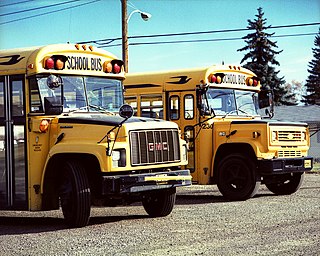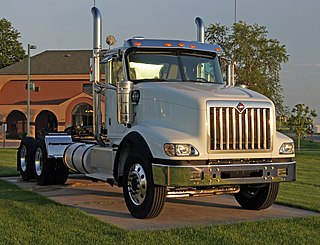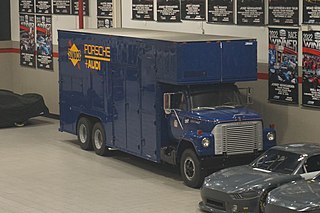
The International Harvester Company was an American manufacturer of agricultural and construction equipment, automobiles, commercial trucks, lawn and garden products, household equipment, and more. It was formed from the 1902 merger of McCormick Harvesting Machine Company and Deering Harvester Company and three smaller manufacturers: Milwaukee; Plano; and Warder, Bushnell, and Glessner. Its brands included McCormick, Deering, and later McCormick-Deering, as well as International. Along with the Farmall and Cub Cadet tractors, International was also known for the Scout and Travelall vehicle nameplates. In the 1980s all divisions were sold off except for International Trucks, which changed its parent company name to Navistar International.

The Ford Super Duty is a series of heavy-duty pickup trucks produced by the Ford Motor Company since the 1999 model year. Slotted above the consumer-oriented Ford F-150, the Super Duty trucks are an expansion of the Ford F-Series range, from F-250 to the F-600. The F-250 through F-450 are offered as pickup trucks, while the F-350 through F-600 are offered as chassis cabs.

The Chevrolet and GMC B series was a series of cowled chassis that were produced by General Motors. Produced across three generations from 1966 to 2003, the model line was a variant of medium-duty trucks marketed under the Chevrolet and GMC nameplates. Initially derived from the medium-duty C/K series, later examples were derived from the GMT530 architecture.

The Chevrolet Kodiak and GMC TopKick are a range of medium duty trucks that were produced by the Chevrolet and GMC divisions of General Motors from 1980 to 2009. Introduced as a variant of the medium-duty C/K truck line, three generations were produced. Slotted between the C/K trucks and the GMC Brigadier Class 8 conventional, the Kodiak/TopKick were developed as a basis for vocationally oriented trucks, including cargo haulers, dump trucks, and similar vehicles; on later generations, both cutaway and cowled-chassis variants were produced for bus use.

The medium-duty version of the Ford F-Series is a range of commercial trucks manufactured by Ford since 1948. Derived from the smaller F-Series pickup trucks, the medium-duty range is currently in its eighth generation. Initially slotted between the F-Series pickup trucks and the "Big Job" conventionals, later generations were slotted below the L-Series "Louisville" trucks; the last two generations are the largest vehicles produced by Ford since its exit from the heavy-truck segment.

The Diamond T Company was an American automobile and truck manufacturer. They produced commercial and military trucks.

The International L series was introduced by International Harvester in fall 1949 as the replacement for the KB series and were available as everything from light pickup trucks and delivery vehicles to full-size tractor-trailers. Electric wipers, a radio, and a clock were optional. International would continue to produce the line until 1952 when it was replaced by the R series.

The International TranStar, is a range of Class 8 trucks produced by Navistar International for North America. Produced nearly exclusively as a semitractor, the product range is focused towards local delivery and regional shipping.

The Ford L-series is a range of commercial trucks that were assembled and marketed by Ford between 1970 and 1998. They are also known as Ford Louisville or, for the 1990s aerodynamic models, Ford Aeromax. The first dedicated Class 8 truck produced by the company, although Ford had been producing "Heavy Duty" trucks since 1948 and their "Super Duty" lineup since 1958. The L-Series was the successor of the F-900/F-1000 Super Duty and the Ford N-Series. The line encompassed a wide range of models in GVWR Classes 6 through 8, as either straight trucks or as semi-tractors, with vehicles developed for medium-duty, on-highway, severe-service, and vocational applications.

The International S series is a range of trucks that was manufactured by International Harvester from 1977 to 2001. Introduced to consolidate the medium-duty IHC Loadstar and heavy-duty IHC Fleetstar into a single product range, the S series was slotted below the Transtar and Paystar Class 8 conventionals.

The International Paystar is a series of trucks that was manufactured by International Harvester and its successor, Navistar International. Produced from 1973 to 2017 across three generations, the Paystar replaced the long-running 210/230 and M-series. Developed for both on and off-road use, the Paystar was the largest commercially-marketed product range sold by International, intended for vocational applications. For 2017, the Paystar underwent a substantial redesign, becoming the International HX series.
The bus chassis variant of the International S series is a cowled bus chassis that was produced by International Harvester from 1979 to 2001. Produced primarily for school bus applications, the chassis was also produced for other applications, including commercial-use buses and cutaway-cab buses. In addition, the cowled chassis formed the basis for front-engine and rear-engine stripped chassis produced for bus applications.

The International R series is a model range of trucks that was manufactured by International Harvester. Introduced in 1953 as the replacement for the International L series, the model line marked the introduction of the IH "tractor" grille emblem on International road vehicles. Sharing a cab with its predecessor, the R-series marked the introduction of four-wheel drive vehicles and the wider use of diesel engines.

The International Metro Van, made by International Harvester, is a step van, also known as walk-in or multi-stop delivery truck. This vehicle type was one of the earlier, mass-produced forward control vehicles, once commonly used for milk or bakery delivery, as well as ambulance services, mobile offices, and radio transmitter vans. Typically, they were 1/2-, 3/4-, or 1-ton panel trucks that allowed the driver to stand or sit while driving the vehicle.

The International 9000 Series is a range of trucks that was manufactured by Navistar International from 1971 to 2017. A conventional-cab truck, the model range was configured primarily for highway applications. In terms of size, the model range was slotted between the medium-duty Loadstar and severe-service Paystar series.

The International WorkStar is a line of severe duty trucks produced by Navistar, Inc. The WorkStar is the successor to the 7400 and 7600 series trucks produced by International. Starting in 2008 the "thousand series" name was dropped in favor of the WorkStar. This change was reflected in the physical construction of the truck in the form of a new hood and grill along with increased MaxxForce Engine options.

The International Fleetstar is a series of heavy-duty trucks that was produced between 1962 and 1977 by International Harvester. Slotted above the Loadstar and below the Paystar and Transtar conventionals introduced after it, the Fleetstar was the first truck line that International designed specifically for vocational use.

The ninth generation of the Ford F-Series is a lineup of trucks that were produced by Ford from the 1992 to 1998 model years. The final generation of the F-Series to include a complete range of trucks from a half-ton F-150 pickup truck to a medium-duty F-800 commercial truck, this is the third generation of the F-Series body and chassis introduced for 1980.

The International Light Line pickups replaced the C-Series as International's Light Line range of pickup trucks in early 1969, for a shortened model year. The name started out as a simple continuation of the previous A-, B-, and C-series trucks. It was largely a rebodied version of its predecessors, with a square-rigged look very similar to the period Scout utility vehicle. The Travelall underwent parallel changes to the Light Line trucks. The light line of trucks was marked by a larger range of transmission and wheelbase options than any of its competitors, and in general the lineup aimed to maximize adaptability. The Light Line was also available as a bare chassis, for special purpose applications. Production ended in late April 1975, as a hard-pressed International chose to focus on the Scout and on heavier machinery.






















